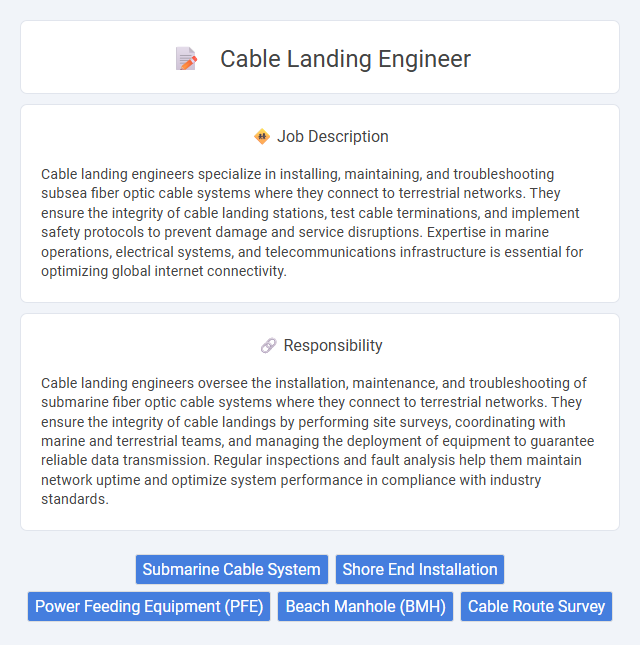
Cable landing engineers specialize in installing, maintaining, and troubleshooting subsea fiber optic cable systems where they connect to terrestrial networks. They ensure the integrity of cable landing stations, test cable terminations, and implement safety protocols to prevent damage and service disruptions. Expertise in marine operations, electrical systems, and telecommunications infrastructure is essential for optimizing global internet connectivity.
Cable landing engineering may suit individuals who are comfortable working in challenging environments, including remote coastal locations and variable weather conditions. Candidates with a strong background in telecommunications and excellent problem-solving skills are likely to adapt well to the technical demands of the job. Those who prefer dynamic, hands-on roles involving physical labor and teamwork might find this career particularly fitting.
Qualification
Cable landing engineers require a strong background in telecommunications or marine engineering, often holding a bachelor's degree in electrical engineering, ocean engineering, or related fields. Proficiency in subsea cable systems, fiber optics technology, and offshore operations is essential, with hands-on experience in cable installation and maintenance projects highly valued. Certifications in safety training, such as BOSIET (Basic Offshore Safety Induction and Emergency Training), and knowledge of international maritime regulations further enhance a candidate's qualifications.
Responsibility
Cable landing engineers oversee the installation, maintenance, and troubleshooting of submarine fiber optic cable systems where they connect to terrestrial networks. They ensure the integrity of cable landings by performing site surveys, coordinating with marine and terrestrial teams, and managing the deployment of equipment to guarantee reliable data transmission. Regular inspections and fault analysis help them maintain network uptime and optimize system performance in compliance with industry standards.
Benefit
Cable landing engineer roles likely offer competitive salaries reflecting the specialized skills required for submarine cable installations and maintenance. Benefits may include extensive field experience opportunities and travel to diverse coastal locations, enhancing professional expertise. There is also a probability of receiving comprehensive health insurance and allowances suited for offshore or remote site assignments.
Challenge
Cable landing engineer roles probably involve complex technical challenges related to underwater cable installation and maintenance. Navigating harsh marine environments and ensuring seamless connectivity might require advanced problem-solving skills and precise coordination. These challenges likely demand a combination of engineering expertise and adaptability to unpredictable conditions.
Career Advancement
Cable landing engineers specialize in the installation and maintenance of submarine communication cables, ensuring seamless data transmission across international borders. Career advancement opportunities often include roles like project manager or senior technical lead, leveraging expertise in cable systems, marine operations, and regulatory compliance. Mastery of cutting-edge technologies and experience in high-stakes offshore environments enhance prospects for leadership positions within telecom and energy sectors.
Key Terms
Submarine Cable System
Cable landing engineers specialize in the installation, maintenance, and troubleshooting of submarine cable systems that connect continents and enable global telecommunications. Their expertise includes overseeing cable landing station operations, ensuring secure and efficient fiber optic cable termination, and coordinating with telecommunications providers to maintain uninterrupted data transmission. Proficiency in marine engineering, fiber optics technology, and compliance with international maritime regulations is essential for successful management of undersea cable infrastructure.
Shore End Installation
Cable landing engineers specializing in shore end installation manage the critical phase of submarine cable projects where the cable transitions from the marine environment to land. Their responsibilities include coordinating the precise burial of the shore end cable, ensuring compliance with environmental and regulatory standards, and supervising the use of specialized equipment like jetting tools and plows. Expertise in geotechnical analysis and coordinating with shore-based infrastructure teams is essential for successful installation and long-term cable integrity.
Power Feeding Equipment (PFE)
Cable landing engineers specializing in Power Feeding Equipment (PFE) ensure the reliable operation and maintenance of power supply systems critical to subsea cable networks. Their expertise includes overseeing PFE installation, monitoring electrical performance, and troubleshooting issues to prevent power disruptions in transoceanic data transmission. Proficiency in high-voltage equipment, cable jointing, and compliance with safety standards is essential for safeguarding network integrity and operational efficiency.
Beach Manhole (BMH)
A Cable Landing Engineer specializing in Beach Manhole (BMH) operations manages the installation, inspection, and maintenance of subsea cable transitions between the marine environment and terrestrial infrastructure. The Beach Manhole serves as a critical underground chamber housing cable joints, splices, and transition modules, ensuring cable protection from environmental hazards and facilitating secure connections to onshore networks. Expertise in waterproofing techniques, structural integrity assessments, and adherence to telecommunications standards is essential for optimizing BMH functionality and project success.
Cable Route Survey
Cable landing engineers specialize in cable route surveys to ensure optimal placement of undersea communication cables. They analyze seabed conditions, environmental factors, and potential hazards to design safe and efficient cable paths. Accurate route surveys minimize risks of cable damage, reduce installation costs, and enhance network reliability.
 kuljobs.com
kuljobs.com